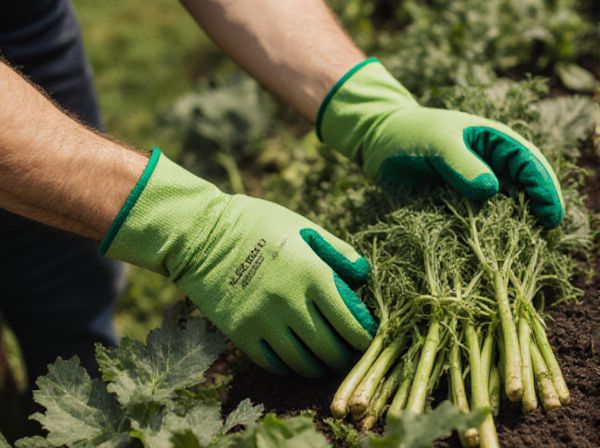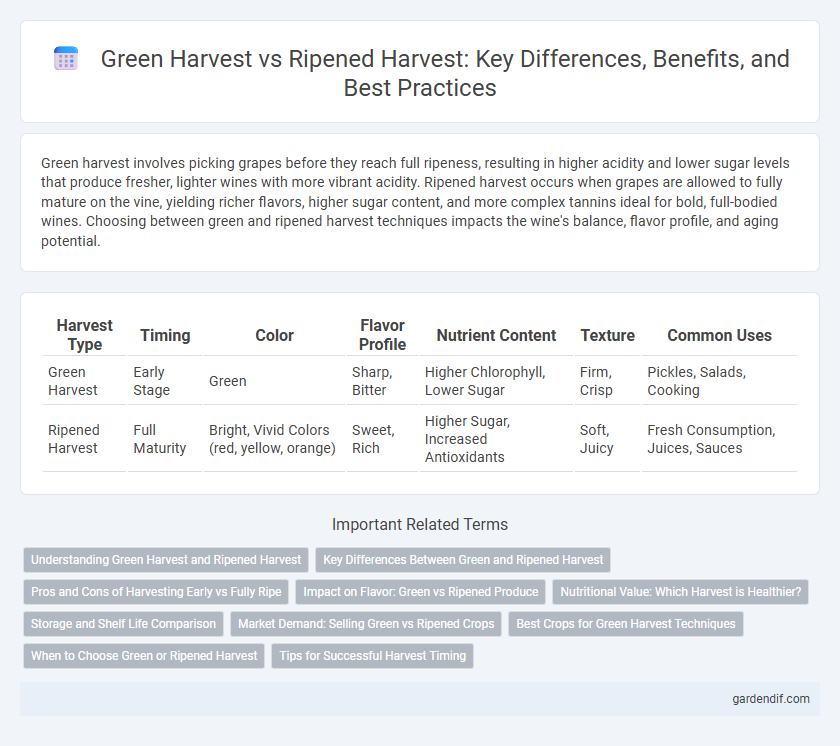
Green harvest vs ripened harvest Illustration
Green harvest involves picking grapes before they reach full ripeness, resulting in higher acidity and lower sugar levels that produce fresher, lighter wines with more vibrant acidity. Ripened harvest occurs when grapes are allowed to fully mature on the vine, yielding richer flavors, higher sugar content, and more complex tannins ideal for bold, full-bodied wines. Choosing between green and ripened harvest techniques impacts the wine's balance, flavor profile, and aging potential.
Table of Comparison
| Harvest Type | Timing | Color | Flavor Profile | Nutrient Content | Texture | Common Uses |
|---|---|---|---|---|---|---|
| Green Harvest | Early Stage | Green | Sharp, Bitter | Higher Chlorophyll, Lower Sugar | Firm, Crisp | Pickles, Salads, Cooking |
| Ripened Harvest | Full Maturity | Bright, Vivid Colors (red, yellow, orange) | Sweet, Rich | Higher Sugar, Increased Antioxidants | Soft, Juicy | Fresh Consumption, Juices, Sauces |
Understanding Green Harvest and Ripened Harvest
Green harvest involves collecting crops before they have fully ripened, often to enhance shelf life or manage supply, while ripened harvest refers to gathering produce at peak maturity to maximize flavor and nutritional value. Understanding these methods is crucial for optimizing crop quality, with green harvest favored in certain fruits like grapes for specific wine profiles, and ripened harvest preferred for fresh market sales. Choosing between green and ripened harvest impacts post-harvest handling, market timing, and overall crop economics.
Key Differences Between Green and Ripened Harvest
Green harvest involves collecting crops before they reach full maturity, resulting in a higher moisture content and less developed sugars, which affects taste and shelf life. Ripened harvest occurs when fruits or vegetables attain full maturity, exhibiting optimal sugar levels, flavor, and nutritional value, making them ideal for direct consumption and longer storage. Key differences include timing, flavor profile, texture, and post-harvest handling requirements.
Pros and Cons of Harvesting Early vs Fully Ripe
Harvesting crops early during the green harvest stage allows for higher moisture content, reducing the risk of pest infestations and enabling quicker market turnover, but it may result in lower sugar content and less developed flavors. Fully ripened harvests maximize flavor, nutritional value, and sugar concentration, enhancing product quality and consumer satisfaction, though they carry a greater risk of crop loss due to overripening or adverse weather. Choosing between green and ripened harvest involves balancing moisture levels, flavor profiles, pest vulnerability, and timing to optimize yield and market demands.
Impact on Flavor: Green vs Ripened Produce
Green harvest fruits contain higher levels of organic acids and lower sugar content, resulting in a tart, astringent flavor profile. Ripened produce exhibits increased natural sugars and decreased acidity, developing a sweeter, fuller taste with enhanced aromatic compounds. The timing of harvest significantly influences the balance of flavor compounds, affecting consumer preference and culinary application.
Nutritional Value: Which Harvest is Healthier?
Green harvest crops typically contain higher levels of certain antioxidants, vitamins such as vitamin C, and dietary fiber compared to fully ripened counterparts, contributing to their potential health benefits. In contrast, ripened harvest fruits and vegetables often exhibit increased natural sugars and enhanced levels of carotenoids like beta-carotene, boosting their nutritional value and bioavailability. Choosing between green and ripened harvest depends on specific nutrient priorities, but incorporating both can maximize overall health benefits due to their complementary nutrient profiles.
Storage and Shelf Life Comparison
Green harvest fruits contain higher moisture and starch levels, resulting in shorter shelf life and increased susceptibility to spoilage during storage. Ripened harvests have developed sugars and lower moisture, enhancing flavor and extending storage durability with reduced risk of microbial decay. Proper temperature and humidity control can further optimize the shelf life of both green and ripened produce varieties.
Market Demand: Selling Green vs Ripened Crops
Green harvest crops often meet early market demand, offering fresher produce with longer shelf life but sometimes lower flavor development compared to ripened harvest crops. Ripened harvest crops attract consumers seeking peak taste and nutritional value, commanding higher prices in premium markets due to their enhanced quality and readiness for immediate consumption. Market strategies balance these factors, with green harvests targeting volume sales and ripened harvests focusing on niche segments valuing flavor and ripeness.
Best Crops for Green Harvest Techniques
Green harvest techniques target crops like spinach, lettuce, and peas, which thrive when picked early for optimal flavor and nutritional value. These crops maintain high chlorophyll levels, enhancing their vibrant color and antioxidant content compared to ripened harvests. Early harvesting also reduces pest damage and prolongs shelf life, making green harvest ideal for leafy greens and tender vegetables.
When to Choose Green or Ripened Harvest
Choosing between green harvest and ripened harvest depends on crop type and intended use, as green harvest typically occurs before full maturity to maximize shelf life and reduce pest damage. Ripened harvest is ideal when peak flavor, nutrient content, and sugar levels are critical, especially for fruits and wine grapes. Factors like weather conditions, market demand, and storage facilities influence the optimal harvest timing for each method.
Tips for Successful Harvest Timing
Harvesting crops at the green stage preserves maximum nutrients and extends shelf life while ripened harvest ensures full flavor and sugar development. Monitor crop-specific indicators such as color change, firmness, and size to determine optimal picking time. Using tools like refractometers for sugar levels or moisture meters improves timing accuracy and boosts yield quality.
Green harvest vs ripened harvest Infographic

 gardendif.com
gardendif.com